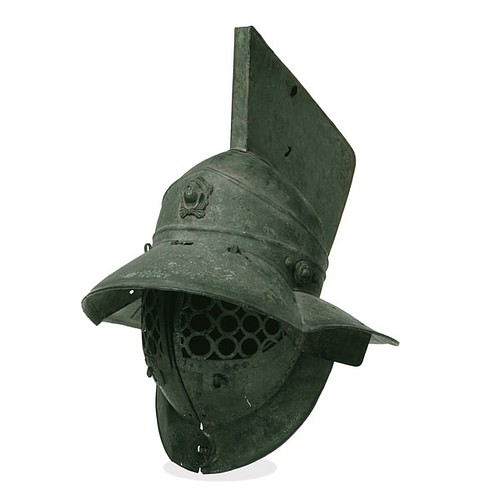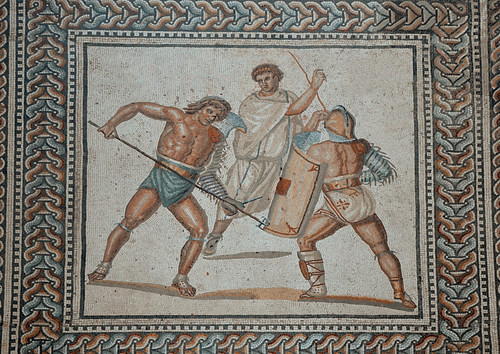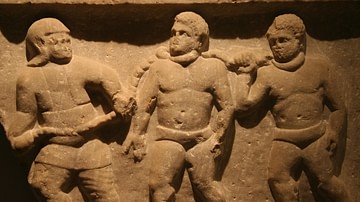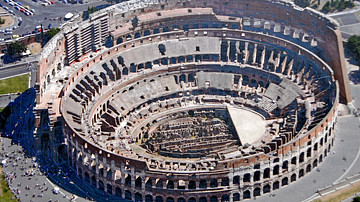
A Roman Gladiator was an ancient professional fighter who usually specialised with particular weapons and types of armour. They fought before the public in hugely popular organised games held in large purpose-built arenas throughout the Roman Empire from 105 BCE to 404 CE (official contests).
As fights were usually to the death, gladiators had a short life expectancy and so, although it was in some respects a glamorous profession, the majority of fighters were slaves, former slaves or condemned prisoners. Without doubt, gladiator spectacles were one of the most-watched forms of popular entertainment in the Roman world.
Etruscan Origins
The Romans were influenced by their predecessors in Italy, the Etruscans, in many ways. For example, in the use of animal sacrifice for divining the future, the use of the symbolic fasces and organising gladiatorial games. The Etruscans associated these contests with the rites of death and so they had a certain religious significance. Although the first privately organised Roman gladiator contests in 264 BCE were to commemorate the death of a father, the later official contests discarded this element. Vestiges of the religious origins did, however, remain in the act of finishing off fallen gladiators. In this case, an attendant would strike a blow to the forehead of the injured. The attendant would wear a costume representing Hermes the messenger god who escorted souls to the underworld or Charun (the Etruscan equivalent). The presence of the divine Emperor himself, accompanied by priests and the Vestal Virgins also lent a certain pseudo-religious air to the contests.
Kings of Entertainment
Roman gladiator games were an opportunity for emperors and rich aristocrats to display their wealth to the populace, to commemorate military victories, mark visits from important officials, celebrate birthdays or simply to distract the populace from the political and economic problems of the day. The appeal to the public of the games was as bloody entertainment and the fascination which came from contests which were literally a matter of life and death. Hugely popular events were held in massive arenas throughout the Roman Empire, with the Colosseum (or Flavian Amphitheatre) the biggest of them all. Thirty, forty or even fifty thousand spectators from all sections of Roman society flocked to be entertained by gory spectacles where wild and exotic animals were hunted, prisoners were executed, religious martyrs were thrown to the lions and the stars of the show, symbols of the Roman virtues of honour and courage, the gladiators, employed all their martial skills in a kill or be killed contest. It is a popular misconception that gladiators saluted their emperor at the beginning of each show with the line: Ave imperator, morituri te salutant! (Hail emperor, we who are about to die salute you!), whereas, in reality, this line was said by prisoners about to be killed in the mock naval battles (naumachia), also held in the arenas on special occasions.
Gladiators most often came from a slave or criminal background but also many prisoners of war were forced to perform in the arenas. There were also cases of bankrupt aristocrats forced to earn a living by the sword, for example, Sempronius, a descendant of the powerful Gracchi clan. It is also of note that until their outlaw by Septimius Severus in 200 CE, women were permitted to fight as gladiators. There were special gladiator schools set up throughout the Empire; Rome itself had three such barracks and Capua was particularly famous for the gladiators produced there. Agents scouted the empire for potential gladiators to meet the ever-increasing demand and fill the training schools which must have had a phenomenal turnover of fighters. Conditions in the schools were similar to any other prison, small cells and shackles for all, however, the food was better (e.g. fortifying barley), and trainees received the best possible medical attention; they were, after all, an expensive investment.
Armour & Weapons
The term gladiator derives from the Latin gladiatores in reference to their principal weapon the gladius or short sword. However, there was a wide range of other weapons employed in gladiator contests. The gladiators also wore armour and their helmets, in particular, were objects of great workmanship, richly embossed with decorative motifs and set with ostrich or peacock plumed crests. Weapons and armour though depended on which class a gladiator belonged to. There were four principal classes:
- The Samnite
- The Thracian
- The Myrmillo
- The Retiarius
The Samnite class was named after the great Samnite warriors that Rome had fought and beaten in the early years of the Republic. Interestingly, the Romans, at least in the early days, used gladiator and Samnite as synonyms, suggesting an alternative origin to Etruscan for these contests. The most heavily armed, the Samnite had a sword or lance, a large square shield (scutum) and protective armour on his right (sword) arm and left leg. The Thracian gladiator had a curved short sword (sica) and a very small square or round shield (parma) held in the fist to deflect blows. The Myrmillo gladiator was sometimes known as the fishman as he had a fish-shaped crest on his helmet. Like the Samnite, he carried a short sword and scutum but had armour only of padding on arm and leg. The Retiarius had no helmet or armour other than a padded shoulder piece and he carried a weighted net. He would try to entangle his opponent by throwing the net and then stab with his trident.
Gladiators fought in particular combinations, usually to provide a contrast between slower, more heavily armoured classes such as the Myrmillo against quicker, less protected gladiators such as the Retiarius. There were many other lesser types of gladiators with various combinations of weapons and armour and names changed over time, for example, 'Samnite' and 'Gaul' became politically incorrect when these nations became allies. Other types of combatants also included archers, boxers, and the bestiarii who fought animals in the wild beast hunts.
Winners & Losers
Those who lacked the enthusiasm to fight were cajoled by their manager (lanista) and his team of slaves who brandished leather whips or red-hot metal bars. No doubt the indignant roars from 40,000 spectators and the unrelenting attacks of one's opponent also convinced many to fight till the end. There were cases of refusal to fight: Perhaps one of the more famous was in the gladiator games organised by Quintus Aurelius Symmachus c. 401 CE when the Germanic prisoners who were scheduled to fight decided instead to strangle each other in their cells rather than provide a spectacle for the Roman populace.
The losing gladiator, if not killed outright, often appealed for mercy by dropping his weapon and shield and raising a finger. His adversary could then decide to be lenient, although, as there was a significant risk of meeting again in the arena, it was considered good professional practice to kill your opponent. If the emperor were present then he would decide, although the crowd would certainly try to influence his judgement by waving cloths or gesturing with their hands - raised thumbs and shouts of Mitte! meant 'let him go', thumbs down (pollice verso) and Iugula! meant 'execute him'.
Victors in the contests, particularly those with many fights behind them, became darlings of the crowd and as surviving graffiti on Roman buildings indicates, they were particularly popular with women - cases of affairs with aristocratic ladies and even elopement were not unknown. Graffiti from Pompeii gives a fascinating insight into how the gladiators were seen by the general public: Oceanus 'the barmaid's choice' or another was described as decus puellarum, suspirium puellarum (the delight and sighed-for joy of girls) and also written were how many victories some attained: Petronius Octavius 35 (his last), Severus 55, Nascia 60. However, it should be noted that the average was much lower and there were even some games in which victors fought other winners until only one gladiator was left standing. More material rewards for winning one's contest included the prestigious palm branch of victory, often a crown, a silver dish heaped with prize money and perhaps, after years of victories, even freedom.
Famous Gladiators
Perhaps the most famous gladiator of all was Spartacus, who led an uprising of gladiators and slaves from Capua, the leading producer of gladiators, in 73 BCE. From Thrace, the former Roman soldier had become a bandit until his capture and forced training as a gladiator. He and seventy comrades escaped from their training school and set up a defensive camp on the slopes of Vesuvius. Besieged, they then fled their position and rampaged through the countryside of Campania, collecting followers as they went and moulding them into an efficient fighting force. Battling his way north to the Alps, Spartacus displayed great military leadership in defeating four Roman armies on no less than nine occasions. Far from being a saint though, when a friend died in battle, Spartacus, in the old custom, arranged for three hundred Roman prisoners to fight gladiator contests in honour of his fallen comrade. After two years of revolt, the armies of Marcus Licinius Crassus finally cornered and quashed the rebels in Apulia in the south of Italy. As a warning to others, 6,000 of the prisoners were crucified along the Appian Way between Capua and Rome. Another consequence of this disturbing episode was that from then on, the number of gladiators owned by private citizens was strictly controlled.
Another famous gladiator was, in fact, a non-professional. Emperor Commodus (r. 180-192 CE) was keen and mad enough to compete himself in the arena, indeed, there were even rumours that he was the illegitimate son of a gladiator. One might argue that Commodus was a professional as he made sure to draw a fantastic salary for his appearances in the Colosseum. However, it is unlikely that Commodus, usually dressed as Mercury, was ever in any real danger during the hundreds of contests he fought in the arena, and his most frequent participation was as a slaughterer of wild animals, usually from a protected platform using a bow.
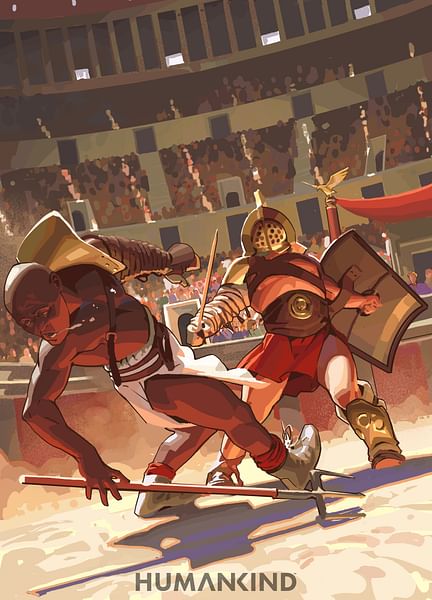
The End of the Show
Gladiator contests, at odds with the new Christian-minded Empire, finally came to an end in 404 CE. Emperor Honorius had closed down the gladiator schools five years before and the final straw for the games came when a monk from Asia Minor, one Telemachus, leapt between two gladiators to stop the bloodshed and the indignant crowd stoned the monk to death. Honorius in consequence formally prohibited gladiatorial contests, although, condemned criminals continued the wild animal hunts for another century or so. Many Romans no doubt lamented the loss of a pastime that was such a part of the fabric of Roman life, but the end of all things Roman was near, for, just six years later, the Visigoths led by Alaric would sack the Eternal City itself.

